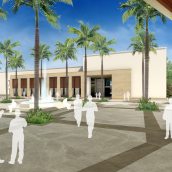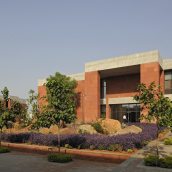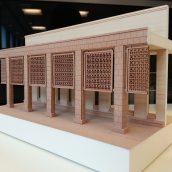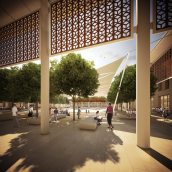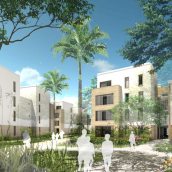A commitment to excellence: Designing the Aga Khan Academies
The idea of a network is a powerful way of understanding the Aga Khan Academies. Each Academy constitutes an individual node, strung by strands of similitude to its counterparts across the globe. A key strand linking these Academies together is a profound commitment to excellence in all areas of endeavour, including the design of the campus and the physical spaces that so strongly shape a student’s educational experience.
Every decision made, from where to plant a tree or flower to the number of steps at an entranceway to how a classroom is designed aims to manifest this commitment to excellence, which permeates through the Academies network at all stages of development. From architectural design to construction, from educational programming though to a student’s educational experience, an engagement with excellence entwines itself throughout the individual Academies, uniting them as members of a coherent community.
Student residences at theAga Khan Academy Mombasa adorned with locally sourced coral stone
Contextually appropriate design
The Academies, as a global network of residential schools, are situated in different contexts in various regions of the world. The design process for each Academy therefore needs to achieve a delicate balance between adhering to network-wide requirements and the flexibility to tailor these requirements to local needs.
While all the schools include common features and types of buildings, these are expressed differently in each Academy campus, drawing from the design styles and materials used in the local context, and reflecting the unique nature of each site. Actively situating themselves in their own context allows each Academy to both be part of a wider network but also have its own distinct character and culture.
The campus in Hyderabad features local rocks in the landscaping.Ensuring that each Academy relates closely to its cultural and geographic context means looking beyond aesthetics. It requires consideration of local climate, building materials, construction techniques and cultural symbols.
For example, the Academy in Mombasa is influenced by local construction materials and design features – building façades are adorned with locally sourced coral stone and Swahili decorative motifs. The design of the Hyderabad campus incorporates local rocks, which are a unique and valued part of the Hyderabad landscape, and in Mozambique, the architectural vocabulary of the Aga Khan Academy Maputo also draws its inspiration locally. Moyez Alwani, the Academies property development Senior Design Manager explains that in Maputo, “Colour is very important, and we have a solution which is very much about earthy colours that are found in that part of the world, and appropriately placed.”
Mashrabiya modelMoyez explains that the design process employs “contemporary methodologies and contemporary advances with contextually appropriate design ideas.” This combination of the contemporary with the contextual has led to innovation, for example in the design of the mashrabiya [ornate latticework window screen] at the Academy in Dar es Salaam. Traditionally, mashrabiya in Swahili style is made of timber and is quite fragile, so in the school context, Moyez explains, “We have taken the conceptual idea of a mashrabiya and are exploring contemporary ways of manufacturing them out of laser cut aluminum or laser cut steel.”
The design process also calls for dialogue across the expanding Academies network to continually ensure the highest standards. While lessons learnt from the design of the first two Academies in Mombasa and Hyderabad are being applied to the expansion of the Academy in Maputo and the future Academy sites in Dar es Salaam and Dhaka, innovations at these newer Academies will also inform and enrich the ongoing development of the older ones.
“The buildings and spaces of the Academies will seek to provide an aesthetically well conceived environment conducive to reflection, study and enjoyment within an appropriate cultural context.” His Highness the Aga Khan, Foundation Stone Ceremony of the Aga Khan Academy Maputo
Elegance and pragmatism
While architectural aesthetics are important, there is also a concentrated effort to ensure that the buildings of the Academies network are user oriented and contribute to the enhancement of the student experience. “We work really hard in the architecture that we produce to ensure the products that are created are user focused,” Moyez explains.
The design of the Dar es Salaam Academy’s courtyard is a poignant example of how a space can be multifunctional and contribute to an enhanced student experience. Taking inspiration from the Swahili word moyo, meaning “heart”, the courtyard symbolises the heart of the Academy. Not just an empty open space, the large courtyard “has been designed to be a talking point between the four main school buildings, and the landscape has been designed to encourage people to sit there, to talk there, to interact and to share ideas. The space has also been designed to accommodate whole-school assemblies.”
The design and use of space can also facilitate the creation of a cohesive student community. Nick Blackmore, the property development Planner and Programmer for the Academies explains that in an environment where students of different backgrounds and cultures will be in constant interaction, spaces like the Commons, the residences, the gardens and the dining halls offer students the ability to bond with and learn from each other.
The "moyo" in Dar es Salaam (architect's rendering)Each of these spaces encourages different experiences. The gardens and dining halls offer the possibility for the students to relax and catch up with their friends, whereas the library and classrooms, for example, will encourage reflection and contemplation. The student residences at the Academies, Moyez explains, are more intimate and offer students the possibility to reflect and communicate on a different and smaller scale of interaction. The gardens and landscapes also offer possibilities for learning and interaction. “Landscape should enhance the learning experience of the student, it should not just be something beautiful to look at.” Each of these spaces carries with it an underlying educational logic. It is hoped that the bonds and friendship groups nourished by students in these spaces will stretch out over their lifetimes, resulting in a network of passionate young individuals who will seek to be global leaders in their respective fields of enterprise.
The built environment and student experience
An intriguing idea at work in the Academies is the use of space to facilitate “memory moments” – moments that will stick with students long after their time at the Academies. In Dar es Salaam, for example, the site for the Academy was occupied by a very prominent and large fig tree. Seeking to include the tree in their design, the architects were asked to redesign the scheme, incorporating the tree into the learning environment of the Junior School. This resulted in an amphitheatre design under the tree, which essentially will be a storytelling space. It is hoped that spaces like these will facilitate moments of memory making which will remain with the students.
The amphitheatre of the Academy in Hyderabad, a natural learning space.The idea that space can have a direct influence on a student’s learning experience is firmly rooted in the belief that the built environment plays an invaluable role in one’s quality of life. Moyez passionately observes, “The built environment is probably the most powerful way to impact quality of life. If you accept that, then your environment shapes everything about your daily interaction.”
Quality of life is also fundamentally linked with quality of academic learning. “You think about the classroom, the light qualities of a classroom, the ventilation in a classroom, whether or not you have air conditioning, all of these things…you connect that to an academic output [and] it is hugely important.” One example Nick provides is that of passive cooling systems that optimise airflow for natural cooling in the classrooms. They provide a solution to air ventilation that is not only environmentally friendly, user oriented and contextually appropriate but that also enhances a student’s quality of life within that space.
Dar es Salaam student residences (architect's rendering)Looking ahead
One of the main challenges to the design and development of the Aga Khan Academies has been the diversity of environments and contexts in which the Academies are established. Every Academy sits on a different site, each with its own topography, size limitation, and surrounding urban and rural environment. Each of these locales is also in the midst of different stages of development. This necessitates asking what the surrounding environment will look like 10, 20 and 50 years down the line. The Academy site in Dhaka poses an interesting challenge. Surrounded by high-rise development, the design of the site will have to respond to this urban reality. One potential idea is that of a protected campus with high-rise buildings toward the exterior of the site, surrounding and protecting an open space in the centre of the Academy.
While every Academy exists in a certain locale and context, each is linked in its ability to foster the development of young individuals who both will excel academically, and go on to become global leaders in their respective fields of endeavour. In his remarks at the foundation stone-laying ceremony of the Aga Khan Academy in Hyderabad, His Highness the Aga Khan noted, “The Academies will be concerned with the whole of the human being – mind, body and spirit – and with the broad range of human aspiration – intellectual, moral, artistic, physical and spiritual.”
Excellence in these areas of human aspiration requires a commitment to excellence in areas from architectural design to quality of life, from the built environment to student experience. Linked in this common aim, the Aga Khan Academies constitute not just a series of individual schools but also a coherent community, a cohesive network of Academies.
By Farhan Karim
Newsletter readers please click here to return to the newsletter (browser version)
publications


